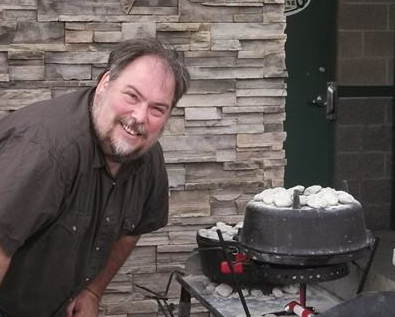 I recently had the opportunity to interview Mark Hansen. Mark is all about Dutch oven cooking, runs what may be the longest continually running website on Dutch oven cooking and has authored four books on Dutch oven cooking (highly recommended and are listed at the end of this post). I had a great time talking with Mark and he gives some super tips, not only about Dutch oven cooking, but cooking in general.
I recently had the opportunity to interview Mark Hansen. Mark is all about Dutch oven cooking, runs what may be the longest continually running website on Dutch oven cooking and has authored four books on Dutch oven cooking (highly recommended and are listed at the end of this post). I had a great time talking with Mark and he gives some super tips, not only about Dutch oven cooking, but cooking in general.
You can listen to the interview below, or read the transcript. or download it and read it later.
[audio:http://outdoorcookingmagic.com.s3.amazonaws.com/Interview%20with%20Mark%20Hansen%20of%20Marks%20Black%20Pot.mp3]PDF Transcript of the Interview:
Interview with Mark Hansen of Marks Black Pot
Or, read it here!
Scott: I am excited tonight to be joined by Mark Hansen. Mark is a Dutch oven cooking expert, runs the well known Dutch oven site, MarksBlackPot.com, has authored four books on Dutch oven cooking and has a fifth one on the way. Mark, it's good to have you with me tonight to talk a little bit about Dutch oven cooking.
Mark: It's great to be here. Thanks for inviting me.
Scott: Thank you. So, why don't we start off by having you tell us how you got going with Dutch oven cooking. How did you get into it?
Mark: The funny thing is before I got started, I didn't really have a whole lot of interest in any kind of cooking, but I had mentioned to my wife, this is probably about, let's see, it would have been around 2006, I had mentioned to my wife that I thought it would be fun to learn to cook in a Dutch oven and then I had completely forgotten about it and the next Father's day, she got me one. She got me this 12 inch shallow Lodge, which really, by the way, is an excellent Dutch oven. But I knew nothing about it at the time, so I seasoned it and I thought, "Well, I'd better learn how to use this thing". We only went camping like maybe once or twice a year so I thought if I'm really going to cook on this thing, I'm going to have to practice on it at home. So I looked up some recipes. The first thing I ever did was pizza and that actually turned out yummy and the family loved it and that was very encouraging, so I kept on doing our family's Sunday dinners on the back porch in the Dutch oven. And so I just kept on doing that. Then probably around a half a year or so later, one of my friends encouraged me to start blogging about it, so I did and I established MarksBlackPot.com. I felt like a total noob, total beginner, but I had learned a lot, so I just started posting my recipes and sharing the things that I was learning as I was learning it and that was in April of 2007 when I first started doing that and it just kept going from there. I kept learning new things. I kept finding new recipes. I got really interested in recipes that are not very traditional for the Dutch oven. More experimental stuff if you will. And I made a real thorough study of how to bake bread and all kinds of stuff and then just kept posting the things that I was learning in the blog.
Scott: Well, that's great. Your blog has been around a long time now and I think that I've heard it's one of the longest running sites on Dutch oven cooking on the Internet right now.
Mark: There are a few good recipes sites that have kind of gone stagnant. I did some digging to find about this. From what I can tell, it's the longest continually running blog on Dutch oven cooking.
Scott: Any idea how many recipes you have posted there?
Mark: By now it's probably somewhere on the order of about 300. 275 or 300.
Scott: Wow. Well there is a wealth of information there for someone who wants to cook in a Dutch oven, that's for sure.
Mark: I tried to kind of organize it so on the right there's some links, a little set of links that can help you sort through some of them. There's one that's a page of collected easy Dutch oven recipes. There's one that kind of introduces you to chicken and beef and all that kind of stuff. One that's just for bread recipes. So that you can go and kind of navigate a little easier and not be lost, clicking, trying to find something in this big haystack, you know.
Scott: Sure, yeah. I don't remember when I first came across your blog but it was probably not long after that and I've followed it off and on through those years as well. So I'm guessing since you've been cooking for this long, starting in 2006, it's 2014, so 8 years, I'm guessing you have more than one or two Dutch ovens.
Mark: Yes, yes I do (laughing). Although my collection of cast iron, grandiose as I might think it is, pales by comparison to some of the folks that I've encountered out in the Dutch oven world. I've probably got about seven or eight; no, last count it was more like about 10 pieces. I'm kind of skeptical of my math here. It's probably somewhere between 7 to 10 pieces of Dutch ovenware, so to speak. All of them the outdoor camp Dutch ovens, not the enameled ones, although I do have one of those too; I'm just not counting that in this collection.
Scott: All cast iron?
Mark: All cast iron. It's possible to do some really yummy things in aluminum Dutch ovens, but, I myself, have never been drawn to it. I've seen again some really wonderful things come out of aluminum Dutch ovens, but there's a very real difference between cooking with the two and if you are accustomed to aluminum, you can do some wonderful things with it. Aluminum heats up more quickly, so you are more prone to hot spots, whereas cast iron heats up more gradually and distributes the heat more evenly throughout all the metal and so you have to be a little more careful of where you place the coals and how you turn the Dutch ovens during cooking so that you are not as concerned with hot spots. Otherwise you can have uneven coloration, especially on baked things like breads and biscuits and that kind of thing. If you're doing stews and chilis, that not going to be that big of an issue. Aluminum does not have to be seasoned because aluminum, of course, doesn't rust.
Scott: Right. So tell me about...I'm guessing you have a variety of sizes. Tell me about those and how you use the different types of sizes.
Mark: Yeah, great question. I've got them all the way from a small 8-inch to a couple of deep 14 inch Dutch ovens that I have and the big deep 14 inches I don't use as often but it's really nice to have them. I like to use them for my holiday turkeys and hams. And since I actually have two of them, two 14-inch deeps, what I like to do is I like to cook two smaller turkeys instead of one big one because I really think that the smaller turkeys are more tender and more flavorful and then I can also do one with one set a seasonings and another with another set of seasonings and I can still feed the whole family. Now in that 14-inch I can actually get a pretty big turkey in it. At one point I did a 19 or 20 pound turkey but I had to give it CPR to get the lid on! But still it cooked up and tasted great. But those are the two big ones and I use those for the larger meats, mostly. Then I have a 12 inch deep and three 12-inch shallows and those 12-inch shallows are my work-horses. That's what I do almost everything in. I do breads. I do my family meals, more single family roasts kinds of things as opposed to larger group roasts. I'll do all those in my 12 inches. Then I have a couple 10-inch Dutch ovens that I do for cakes and desserts and occasionally for side dishes. And then the 8-inch. And the 8-inch was really cool. My son picked it out for me for my birthday one year. And it's this tiny little thing and I thought, it's cute, but I'll never use it. And it turns out I use it a lot for things like sauces and rice and side veggies and all kinds of things like that. I'm constantly using that 8-inch. So, you're just never sure. (Laughs) And I also have...it's called an oval roaster. Imagine if you took a 10-inch Dutch oven and you stretched it out so it's a little over...maybe it's more like a foot and a half long and I've seen a lot of real cool things done in that, like you can do a whole rack of ribs in it. People do a whole length of salmon in it. I mostly use it to do long French breads.
Scott: Oh, interesting.
Mark: Which you can't do obviously in a circular Dutch oven. And I also did a long flat focaccia loaf in that Dutch. So it's always kind of cool to have that sort of adaptability.
Scott: That sound like quite a collection and it sounds like you can do quite a variety of things in your collection. One of the things that's always fascinated me about a Dutch oven is all the variety of things that you can do in a Dutch oven. Everything from baking to soups and stews to almost like a pressure cooking type of a situation.
Mark: That's actually one of the things that makes the Dutch oven such an effective cooking utensil is because you get the heavy lid that traps the moisture and when I do a turkey, again, for example, that keeps the bird very moist. In a traditional indoor oven, a lot of that moisture is going to vent out with the heat, but in a Dutch oven it's all trapped and that keeps the food very moist and that's OK; that's what you almost always want. Your food gets kind of steamed as well as cooked. There have been times, however, when I've wanted to cook something and have it not be steamed. Have it be more dry cooked. And to do that what I do is get little pieces of metal to put on the rim around the Dutch oven and normally what I just use is a fairly thick nail that I bend over in a U-shape and I set those in various points on the Dutch oven lid, or on the rim of the Dutch oven and that I put the lid down on it and there's a slight gap, so there's no longer a seal and the moisture can vent out. And I use them a lot like, like the first time that I ever did that was when I did Jamaican jerk chicken, because you want that sauce to bake onto the chicken and you want it to glaze on. Right?
Scott: Right.
Mark: Almost everything else it's OK if it gets that moist steam kind of flavor. But occasionally you want it to be dry cooked. And it's kind of cool, because in bread making, especially if you're doing some of these rustic artisan breads, often what they'll do in a regular oven is they'll put a little cup of water like a steam bath in there and that extra steam makes that really crunchy crust. Right?
Scott: Right
Mark: Or they'll spray-mist water onto it. I don't do that because all that steam is trapped by the Dutch oven lid.
Scott: So it doesn't take--you don't have to have much of a gap to...when you want it to vent out. It doesn't require...because a nail wouldn't give you much. That's ok?
Mark: Right. And when you do that, by the way, just as a hint, when you do that, you'll want to put a lot of additional coals because with that steam, you're also venting out a lot of the heat. Even as much as double the coals on top to maintain that same temperature inside.
Scott: That makes sense. That's a great tip.
Mark: I did some...I guess you would call them chicken fingers, the chicken sticks where I chopped up chicken breasts and breaded them and fried those and then baked on a buffalo sauce, a homemade buffalo sauce using that same technique and that was really delicious because then it's not dipped into the sauce, it's actually baked into the breading of the chicken. That was yummy.
Scott: I'll bet it was.
Mark: And that recipe is on the blog, too.
Scott: Oh, is it? OK. I'll look for it. You're making me hungry already!
So you've written four books and you have another one on the way. Why don't you tell us a little bit about each one the books and maybe even how you got started writing the books, how did that come about and then a few minutes on each one of the books.
Mark: I actually... as soon as I started writing the blog and started collecting these recipes, I thought to myself it would be fun to do a book but I didn't really think about it too seriously because self publishing is expensive and I didn't really feel like I knew enough to approach a publisher or anything like that so I kind of just put it out of my head but then about four or five years in on the blog, I got an e-mail from a publisher who had found the blog and they wanted to do cookbooks. And so that was wonderful because then I didn't have to contact them and I didn't have to go grovel at their doorstep and they said we're really interested and we see you've got a lot of good content here at the blog, send us a few proposals. So I wrote up three proposals for them and then they came back with a four book contract which we now, of course, fulfilled and then we have another contract for this fifth book.
The first book was called "The Best of The Black Pot" which is some of my favorites and a good variety from, what was at that point, five years of blogging. And I went through and I handpicked recipes that were both easy and challenging and traditional and experimental and just a good variety and I added in a bunch of additional family recipes and a few additional advice-kinds-of-articles in there, in the pages and so that was just a really good overview of Dutch oven cooking and that's actually been the best-seller of all of them.
Then the next one was a beginner's book I've called "The Black Pot For Beginners" and that one was actually more written from scratch as opposed to just taking recipes from the blog and I set it up so that instead of chapters, it actually has lessons and I organized it so that in each chapter there's a concept being learned. Like heat management and then there's some recipes that helps that. Knife skills...recipes that help with that. Spices and herbs and all kinds of things and if someone were to pick that book up and go chapter by chapter, lesson by lesson through the whole book , by the end of the book, they'd be a pretty skilled and accomplished Dutch oven chef.
The third one is called "Around The World in a Dutch Oven" and it's more international dishes and kind of more challenging and experimental dishes.
And the last one is all about just baking breads in a Dutch oven using coals. And that one was a real challenging one for me because as I was learning to cook in the Dutch oven, I found lots of cookbooks that...lots of Dutch oven cook books that had bread recipes in them and there were lots of cookbooks that were all about how to do bread but there was no book that I could find that was all about how to bake bread in a Dutch oven that had the kind of depth with the instructions. Because baking bread is only partly about ingredients and recipe; it is so much the process and I spent probably a good three years practicing and trying to get to the point where I could put out a consistently good loaf of bread in my Dutch oven. So that's the four books.
Scott: OK, those are the four and you've got one more on the way.
Mark: Yes, that one I'm still in the process of. It's all about using your Dutch oven to cook from your food storage. So if you get in a power outage or you get in some other kind of crisis you can still cook and eat well.
Scott: You can have gourmet meals. Well that's great. I actually have the first two books and I really enjoyed them. Not only do they have recipes but they are just packed with tips and information about cooking, and so I'm looking forward to getting the next two and then your last one when it comes out.
Mark: I find that so much of what I've learned is I've really learned how to cook. And how to do in a Dutch oven.
Scott: Yes, so I read that in your book and it was quite interesting to me. Why don't you talk about that just a little bit more.
Mark: Well the Dutch oven is just the vehicle, right, it's just the particular means of cooking that you've chosen and so much of what I've learned over the years is just basic culinary techniques, you know. How to use a knife and why that affects your cooking. How to control the heat. How to understand spices and flavorings. What are the various processes and methods of cooking, you know? What's the difference between baking and braising and roasting and all those kinds of things? And the fact that I happened to do it in a Dutch oven is just a different approach.
Scott: How did you go about gaining that knowledge, other than practicing. Where did you learn it?
Mark: A lot of reading. You mentioned practicing. A lot of practice. And a lot of YouTube, actually.
Scott: A lot of YouTube? Oh, interesting! Ok!
Mark: But you have to be real careful when you learn things on YouTube. Because there's a lot of people out there with YouTube videos and they each say that everybody else is wrong. So what you have to do is watch a whole bunch of videos and by doing that you kind of learn what is most consistently taught.
So when I got my first real chef's knife and I wanted to learn how to really hold it, I watched a lot of videos and by doing that I kind of gathered.. ok, well, holding it this way is a good thing, holding your other hand this way and holding the food this way will keep you from losing fingers and I got my knife technique pretty much down and then the funny thing was, after going through that process, like six months later, I was watching "Good Eats" and Alton brown teaching all about knife skills (Alton Brown is one of my heroes, by the way).
Scott: Yeah, I enjoy watching him.
Mark: And there he was, teaching the exact same technique that I had gleaned from watching lots of YouTube videos. So I've felt pretty confident that I've learned the right thing.
Scott: That's great. I was not expecting that you were going to say YouTube videos but that is definitely a place I go to for things sometimes as well.
Mark: Yeah, I mean there's so much stuff there. I learned how to make pasta by hand and not just mix it and put it into that roller machine. I'm talking like actually roll it out on your table top using an inch and a half dowel as a big rolling pin. I learned that on YouTube. This lady went to visit her grandmother in Sicily and videotaped (well, not videotaped), but videoed her old grandmother, her old Sicilian grandmother going through the entire process, in Italian too, by the way! So I learned how to do...make pasta that way.
Let's see, what else? There's been a whole bunch of things like that that I've learned just by a lot of reading, a lot of recipes. The problem, though, with cookbooks is that too often they assume that you know what they're talking about. And that's something I've tried very hard to overcome as I write in my blog and write my cookbooks...to write the stories of how I go about cooking things because...well, there was when I was making this Russian dish that had a filling of rice and salmon and onions and tomatoes all wrapped up in this pastry dough, ok? And the cookbook I was pulling this out of said to make a certain amount of what it called puff pastry. Great! So I went to the back of the book and I looked up the index and I found puff pastry and I turned to that page and I made that and it did not look like pie crust at all. It was more of a batter than it was a pie crust. And I thought, "Maybe I got the proportions wrong", so I threw it away and mixed it up again and it came out exactly the same way and I thought "What on earth is going on?" And so I kept reading the recipe over and over again and I...finally I went the back of the book, to the index, and I looked in another spot and I found another recipe in the same book that was also named puff pastry and that was the one that came out looking like a pie crust. I ended up wrapping the filling in it and baking it and turned out to be incredibly delicious.
Scott: Hmmm. That's interesting.
Mark: And so what I've learned over time, with cookbooks they often assume that you already know how to make puff pastry or they assume that you already know how long you are supposed to knead the bread, or they assume that you already know how to poach this vegetable. Do you see what I'm saying?
Scott: Right, uh huh.
Mark: Rather than giving you some real instructions and stepping you through it. That's frustrated me over the years.
Scott: Yeah, that makes sense.
Mark: So thanks for letting me vent!
Scott: That's ok! So one of the things that I saw in one of your books, during your education process, was a technique you used to learn about spices and the different flavors that they would bring to your dishes. Tell me about that.
Mark: Yeah, ok, this is something that I'm really excited about because I came up with this one on my own. I thought it would be very helpful to really be able to identify what a spice...an individual spice brings to a dish, right?
Scott: Right.
Mark: Because, so often you just sort of like, I don't know how it's going to taste, I'll just shake it in and see, or you just follow the recipe and someone else has already spelled out which spices you are supposed to use and what proportions, right?
Scott: Right!
Mark: So you don't really get why they are there or what they are doing or how it's changing the flavor, you just follow the instructions. So what I thought was, if there was a way you could really taste each individual spice and get a feel for how that tastes then you could better interpret when you are supposed to use each spice, right? I got a whole bunch a little tiny sample cups and put like a tablespoon of room temperature butter in each one and I picked unsalted butter...I picked butter because I know that a lot of herbs and spices have their flavors activated by oils, which butter of course is, and also butter is a flavor that everyone already knows. So it could be a very good neutral carrier, right?
Scott: Yep, that makes sense.
Mark: So, in each of those cups I put in like about a teaspoonful of that particular spice and stirred it all up, let it sit for a few minutes, to absorb the flavors, and then I spread that on some French bread, and again, I chose French bread because it's very neutral. It doesn't have a strong flavor like a rye might, but it's also something that's very familiar, so it would be very easy to... the only way I can think about is to tune it out in your mind, do you know what I mean?
Scott: Right, uh huh.
Mark: So as you're tasting you can kind of tune out the breadiness, and you can focus just in on the spice. So with the bread spread with each of these spices I just started tasting it and then in that book I went to the next step and started to describe in words what each spice tasted like, which was very, very difficult. Because, you know, how do words describe flavors, right? But I was really surprised by some of them and, you know, some of them were pretty obvious, like pretty much everyone knows what garlic tastes like. And so, obviously that tasted very garlicky and I was like, great, well, duh!
By the way, I have learned over the years that I don't like garlic salt.
Scott: Oh, OK.
Mark: Because I like to have salt, and I like to have garlic powder and I like to be able to adjust how much I want of each one.
Scott: Oh, yeah, that makes sense.
Mark: Whereas if buy a bottle of garlic salt, then someone else has decided that for me.
Scott: Yeah, so you can adjust it.
Mark: So now I get my salt and I get my garlic power separately. I actually make most of my own spice rubs and spice accommodations myself too, but that's neither here nor there.
Scott: Oh, do you?
Mark: So anyway, as I was doing these tastings, some of them really surprised me. I discovered, for example that really good fresh smoked paprika is amazing! I always thought that paprika was primarily just for color. Well, that was because my paprika was old and bad. So naturally it's flavorless because it wasn't fresh, it wasn't new, and was not the best quality in the first place. Then, when I got some real good smoked paprika, fresh, and I was like, "Oh my gosh!"
Nutmeg is so often used in sweet dishes, right? And yet, itself, it's kind of earthy and bitter. It doesn't have a sweet flavor on its own, but if you mix it in sweet things, wow! See what I mean?
Scott: I do, yeah. I've thought about doing this activity. I'm going to do it. It's definitely on my list of things to do and I'm really excited to try this and see what I learn, so that's an awesome suggestion.
Mark: When you do, blog it.
Scott: Ok!
Mark: So we can get your impressions too.
Scott: Ok.
Mark: Sage and thyme, for example, kind of made me pucker.
Scott: Really?
Mark: Uh huh. And there's a word actually for that; it's called astringence. And it kind of, almost, dries out your mouth and it's really kind of weird...
Scott: That's interesting.
Mark: ...how to describe and get those feelings. And then what I found is that I actually did that experiment a couple of times. That helped them cement it more in my mind. Then when the time comes to actually use those it's much more "fun" even is a better way to put it; it's much more effective obviously, but it's much more fun to know "oh, this is going to be that and this is going to do that"
Scott: Yeah, that sounds great. I'm really looking forward to that.
Mark: Once again that's all about learning culinary skills and that you happen to be using that in a Dutch oven. It's not "Dutch oven cooking" that you're learning. You're learning cooking--in a Dutch oven.
Scott: Yeah, I agree with that and that's a very important point of view. So, a few years ago I was back east and talking with a bunch of people and we got on the subject of various outdoor cooking activities; mostly back there it's grilling and barbecuing and that type of thing. Very few...I don't know if I even met a single person who had done Dutch oven cooking. They had heard of it, maybe had experienced eating something like a dessert from a Dutch oven but nobody did it at all. I was really surprised and so we talked about that quite a bit. So...my question...You've obviously done it for awhile...what is it about doing Dutch oven cooking that you enjoy? Why do you do it?
Mark: Well I love it because of a lot of reasons. One of the main reasons is that it slows me down. It is a slower cooking process.
Scott: Not like a microwave.
Mark: Right, there is no such thing as a microwave Dutch oven. And I don't really like to microwave stuff to heat it up anymore.
Scott: Ok!
Mark: I do because life requires that I do that but I don't like it. So, cooking something more steadily, more slowly, not only makes it taste better, but it relaxes me, which is why I kind of enjoy those Sunday evenings with just me and my Dutch ovens and go away, I'm cooking. Leave me alone. To the untrained eye it might seem like I'm just sitting in a chair having a soda, but I'm cooking! Right?
Scott: Right!
Mark: And it forces me to unwind and unplug and (well, that's not entirely true, because I Iike to live-tweet a lot of the pictures of things that I'm cooking).
Scott: Oh, do you? I didn't know that.
Mark: They go to my Facebook page, though.
Scott: I'm sorry. They go to your Facebook page?
Mark: Yeah, that's mostly there when I'm cooking. And that's at Facebook.com/MarksBlackPot.
Scott: Ok.
Mark: So I like a post a lot of those kind of pictures, so I guess I'm not fully unplugged when I'm cooking. But I'm definitely unwinding.
Also, there's kind of a satisfaction of mastering the challenge because, any type of outdoor cooking, but especially Dutch ovens, has a lot more variables that are harder to control than you get in indoor traditional kitchen. It's a lot easier to control the heat, a lot easier to check the time. A really good example is doing breads. How do you tell if a bread is done? Well, I set my temperature at the right temperature according to the recipe and I set my timer according to the recipe and when it dings, it's done, right?
Scott: Right.
Mark: Because temperature and time are constants, right? Not in a Dutch oven. You can't guarantee me by putting these coals in this pattern with the variations in the wind and the outdoor temperature and the weather and everything you're just not sure you're getting this exact same temperature, right? So, just going to a certain time isn't going to guarantee that it's actually done. So what I actually like to do is, I actually like to stick a little short stem meat thermometer in my bread loaf and I check it and when it's at 190 or 200 degrees, I know it's done.
Scott: The more sure way.
Mark: Right. And so there is that additional challenge and to be able to cook something that's not supposed to be done in a Dutch oven and have it come out great that's a really cool feeling.
Scott: I'll bet that is.
Mark: Because it is more challenging. Another reason I like it is because it kind of connects me to my pioneer ancestors. I had my family on my mom's side that crossed the plains with the Mormon expeditions that went from Illinois to the Utah Basin and the whole history of the American West was told in Dutch ovens. All the way from Lewis to Clark all the way to the cattle drives to the Mormon trail, the Oregon Trail. That's what they cooked in, right?
Scott: Yeah.
Mark: And so it connects me. Now, I know I'm sitting here in this comfortable house in my comfortable backyard and I don't have to worry about coyotes or whatever, rattlesnakes or whatever other issues my pioneer ancestors dealt with crossing the plains but I somehow connect to them when I'm cooking in the same cast iron.
Scott: Right. And you get to use Kingsford instead of dried buffalo manure.
Mark: Yes, that's a big plus.
Scott: That's a big plus!
Mark: I have not had the joyous experience of smelling dried buffalo manure.
Scott: No, not on my list to do, actually!
Mark: Whole grain dried buffalo manure. I'll stick to the Kingsford.
Scott: Right! Well, let me close by asking you this: If somebody was just getting started with Dutch oven cooking, like you were eight years ago, what tips would you give them to get started and what might be the first dish you would recommend that they try.
Mark: Well, actually in that beginner's guide book, the first dish I have them do is a chicken and potatoes dish, which is really very simple. You just cut up the ingredients and put it in and bake it, you know. So that's why I chose that because it's delicious, it's simple, it's flexible, so, you know, you'll really can't go wrong with it. So that would be a great one to start with. Really, when I think back on it, pizza was probably a pretty bad one to start with. I was lucky.
Scott: Yeah, I was actually surprised you chose that one.
Mark: Yeah, I kind of got lucky. Of course I used a packaged mix for the crust and I just opened up a jar of Ragu for the sauce, both of which would be blasphemy in my house now.
Scott: (laughs). But what did you know back then, right?
Mark: Right! Yeah, sure, whatever! Here's the secret to good pizza though, by the way.
Scott: What's that?
Mark: Quality toppings.
Scott: OK.
Mark: Quality toppings will cover a multitude of sins.
Scott: OK.
Mark: Use real cheese and not Velveeta. Use good quality pepperoni, good quality sausage, like, instead of getting breakfast sausage, use mild Italian sausage.
Scott: OK.
Mark: If you just pay attention to the toppings...good fresh onions and fresh peppers and all that kind of stuff, then it will be amazing.
Scott: Great tip.
Mark: Yep. A lot of times, people just throw the pizza together with whatever they've got, which is OK. You've got it, use it, right? And actually that's a really good tip for any kind of cooking. The better and the fresher your ingredients, the better anything is going to taste.
Scott: Yeah, I believe that, definitely.
Mark: So there you go on that.
Scott: OK, so you mentioned a dish to start with. Any tips for somebody getting started?
Mark: Dive in and just learn by doing. Be willing to experiment and be willing to fail. When I was doing all those breads, I cooked a lot of bricks. My family still laughs about the great failed apple pie attempt that ended up kind of more like a mushy platform of floury sort of crust with a kind of an apple sauce drizzle on it. It was really not pleasant.
Scott: Oh dear. OK.
Mark: It was a learning experience.
Scott: Sure, right! And that's what beginners need to do: learn.
Mark: So be willing to make all those kinds of mistakes, but don't be afraid to try anything. There is very little that you can do in a traditional oven that you cannot also do in a Dutch oven. You may have to adapt it. In fact, I haven't really found anything that I'm sure I cannot do, but I've had to adapt some things.
Like I did tandoori chicken a couple of times. And obviously, it's not a tandoor. It's not that same kind of cooking but it still tasted great with the spices, and it's nicely baked on and it was wonderfully yummy, and so, there you go...you can do tandoori chicken. You can do just about anything and just be willing to try it.
Scott: Great tip.
Mark: You don't even have to spend a lot of money on fancy tables and have hundreds of pieces of cast iron in your collection. You can just start up, build it up, and if you see you need a Dutch oven, buy it, and go on from there.
Scott: Alright, that's such a great tip. Well, Mark, I appreciate you being here and sharing with us some tips and your story about getting started with Dutch oven cooking. To close, why don't you tell people where they can find out more about you, where they can find out about your books, and if they need to get a hold of you, how would they do that?
Mark: Yeah, that's all at MarksBlackPot.com. I've got links to the books at Amazon, so you can just click right in and buy them there, I've got...so all the information about the books are there. There is an e-mail link if you have a specific question about cooking and you need to get an answer. Most of the time when people ask me questions like that, it usually ends up in the blog itself. I usually like to share those questions so everyone can learn from it.
Scott: Right.
Mark: Well, yeah! MarksBlackPot.com.
Scott: Awesome! MarksBlackPot.com. Great. Well, thank you so much.
Mark: Thank you.
----------
That was fabulous. I have two of his books and will getting the other two soon. If you have any interest in Dutch oven cooking I encourage you to pick up one or more of Mark's books.
Best of the Black Pot
Black Pot For Beginners
Dutch Oven Breads
Around the World in a Dutch Oven


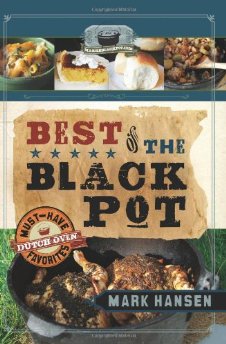
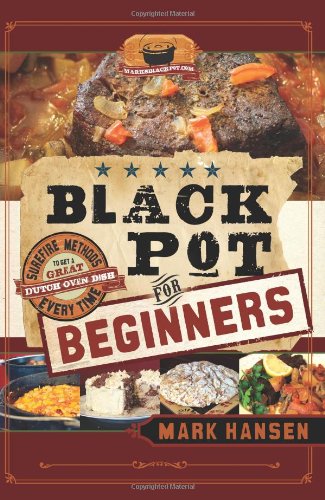
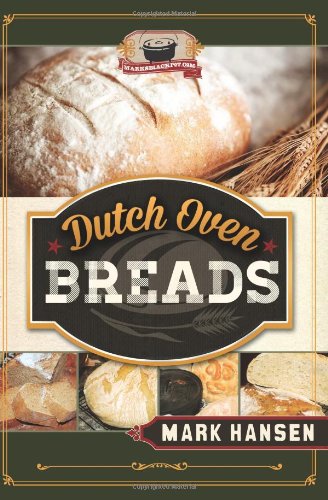
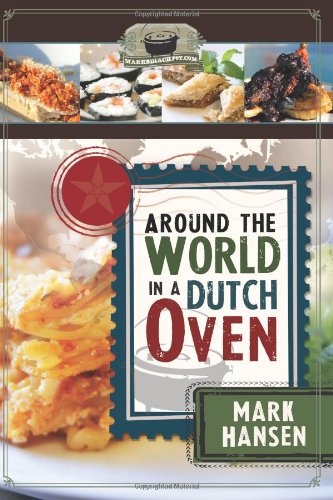
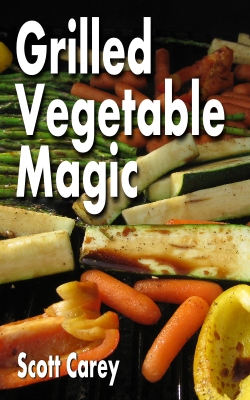
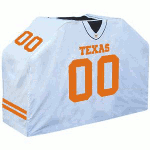
Recent Comments